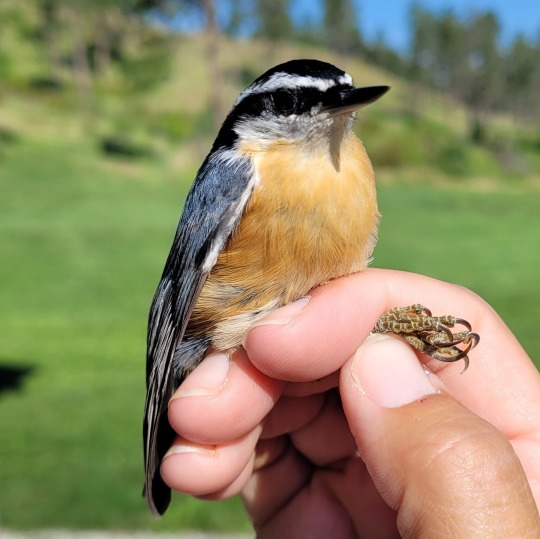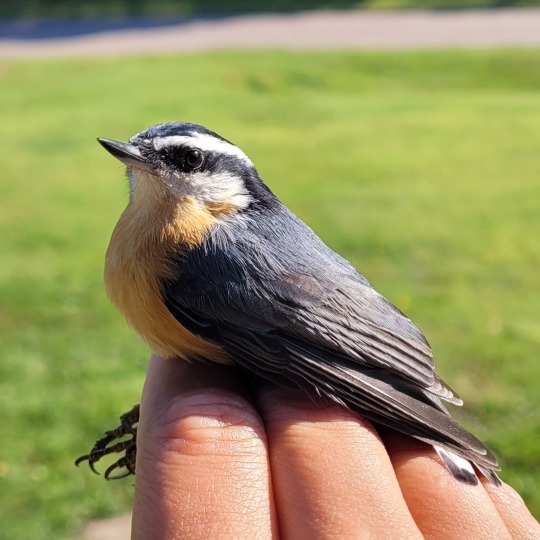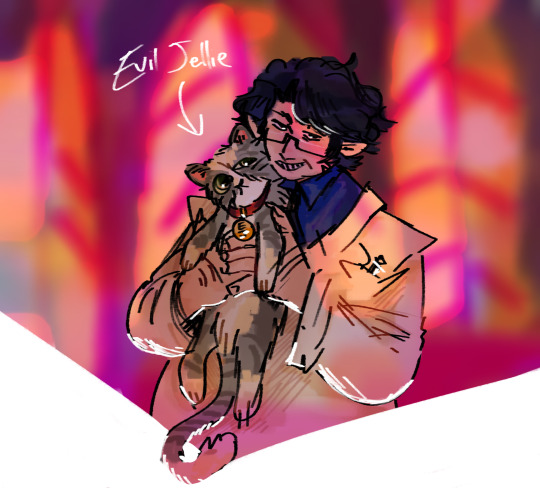#Sitta canadensis
Explore tagged Tumblr posts
Text
BOTD: Red-breasted Nuthatch

Photo: Becky Matsubara
"With its quiet calls and dense coniferous forest habitat, this nuthatch may be overlooked until it wanders down a tree toward the ground. It often shows little fear of humans, and may come very close to a person standing quietly in a conifer grove. Red-breasted Nuthatches nest farther north and higher in the mountains than their relatives; when winter food crops fail in these boreal forests, they may migrate hundreds of miles to the south."
- Audubon Field Guide
#birds#red breasted nuthatch#birds of north america#north american birds#birds of the us#birds of canada#nuthatches#passerines#birding#bird watching#birdblr#birblr#bird of the day#Sitta canadensis
67 notes
·
View notes
Photo

Red-breasted Nuthatch
442 notes
·
View notes
Text


Red-breasted Nuthatch (Sitta canadensis), family Sittidae, order Passeriformes, Saranac Lake, NY, USA
photograph by Jack Peneston
438 notes
·
View notes
Note
i just recently discovered your artwork and it is absolutely gorgeous!! could i request a red-breasted nuthatch? if not, no worries, i hope you are having a good day [:
Hope you have a good day as well!

Red-breasted nuthatch (Sitta canadensis)
You can watch the speedpaint on my youtube here!
#digital illustration#digital art#artwork#artists on tumblr#birds#birdwatching#bird art#birbs#birb#illustration#illustrator#artist support#cute#wildlife art#animal art#birdblr#bird#my art#digital drawing#lineless art#lineless illustration#lineless style#speedpaint#doodle#drawing#artist#requests#asks#ornithology#nuthatch
101 notes
·
View notes
Text

This may not seem like a very impressive photo, but it's very exciting for me! I just set up my bird feeders in Portland a few weeks ago, and unsurprisingly no one showed up immediately. The scrub jays found the endless plate of peanuts after a few days because they're just smart that way, but since the two old cherry trees in front of the apartment building got cut down last month the most convenient shelter for smaller birds to retreat to after visiting the feeder is gone.
Imagine my joy this morning when I got up and saw not one but TWO red-breasted nuthatches (Sitta canadensis) visiting the black oil sunflower seed feeder! One female (pictured here) and one male, likely a mated pair, have been flitting back and forth, making their little chittering sounds back and forth (as opposed to the territorial "beeping" more commonly heard earlier in the year.) Hopefully their activity will signal to other songbirds that there's food, and the local woodpeckers will discover the suet feeder.
I know bird feeders have become increasingly controversial in recent years, due in part to the risk for disease transmission. This is why it's so important to clean them regularly, not just removing old food but spraying them down with a 1:9 bleach:water solution and then scrubbing thoroughly with hot soapy water. I've only ever had one house finch with conjunctivitis show up, and I was quick to bring the feeders in and leave them in for a few weeks before cleaning and putting them back out.
And yes, I agree that a yard full of native plants that provide year-round food opportunities for birds and other wildlife is ideal. However, I don't have a yard. I have a 3x8 balcony, and I live in one of the older neighborhoods in Portland that, but for a few yards, is pretty scarce on native plants and pretty heavy on non-native ornamentals, so natural food sources are thin on the ground for those birds and other wildlife that are tolerant of urban living.
I'll get some natives in pots next spring for pollinators, but apartment management says I have to remove any dead vegetable matter in the fall, which means getting rid of seeds birds would normally eat over winter. I won't be able to create an appreciable amount of food for birds in this space, so feeders are the next best option, giving them something to eat without further reducing their fear of humans. (Let's be clear: any wild animal that lives in this neighborhood has got to be pretty tolerant of us, but that doesn't mean we should be encouraging them to be even less wary.)
Plus, quite honestly, they're good for my mental health; while I don't regret my move back to Portland, I do miss the easy access to a wide range of native biodiversity right outside the door. Being able to once again look out my window and see birds visiting is really good for me, and helps me get through those days when I am stuck at the computer for far too long.
#birds#birbs#birdblr#birdwatching#birds of Tumblr#red-breasted nuthatch#songbirds#wildlife#animals#wild animals#urban wildlife#urban nature#bird feeders
22 notes
·
View notes
Text

Red-breasted Nuthatch; Sitta canadensis
#photography#original photography#nature photography#bird photography#animal photography#pnw#canon camera#washington#birds#red breasted nuthatch#small birds#birding
38 notes
·
View notes
Text


[ID: Two photos of a red-breasted nuthatch perched on the end of a broken-off branch. End ID]
Red-breasted nuthatch (sitta canadensis)
December 31st, 2024
My yard, Minnesota
#birds#nuthatches#red breasted nuthatch#photography#wildlife photography#animals#minnesota#backyard birds#my photos
4 notes
·
View notes
Text

Red-Breasted nuthatch
Sitta canadensis
121 notes
·
View notes
Text


Red-breasted Nuthatch (Sitta canadensis)
Chadron State Park - Fall 2023
These's guys are just the light of my world. While Pygmy Nuthatch are my faves of the bunch, theyre only present in the Western portion of the US and the family group around my station hasn't been seen much so far this year.
Red-breasted Nuthatch, on the other hand, have a range spanning the entire US in the winter, and in several regions they can be seen year round. The tiny squeaks they make while foraging gave them the nickname "Tiny Tooter" in my birding group, since they sound like little toy trumpets. The squeaks get even cuter when the parents and young are chattering together.
All banding, marking, and sampling is being conducted under a federally authorized Bird Banding Permit issued by the U.S. Geological Survey's BBL. Permission to share images was granted by Bird Conservancy of the Rockies (BCR).
14 notes
·
View notes
Text


Red-breasted nuthatch (Sitta canadensis)! They’re rarer around here than their white-breasted cousins so seeing one is always a treat :)
5/2/23
4 notes
·
View notes
Text

Red-breasted Nuthatch ~ Sitta canadensis ~ Sittelle à poitrine rousse ~ My yard in Sparta, NJ
#Nuthatch #Red_breastedNuthatch #Sitta #Sittacanadensis #Sittelle #SitelleÀPoitrineRousse #Trepador #TrepadorCanadiense #Sparta #NewJersey #NJ #Birds #Oiseaux #birdsofinstagram #wildlifephotography #Wildlife #closeup #closeupphotography #oiseauxmigrateurs #oiseauxerrants #livebirds #Ornithology ~ https://www.flickr.com/photos/rachidh/albums
0 notes
Text

Cub: red-breasted nuthatch (Sitta canadensis)

Evil Jellie: Boreal Chickadee (Poecile hudsonicus)

remembered that evil jellie existed day made
#cubfan135#cubfan#jellie#jellie gtws#evil jellie#hermits as birds#mcyt as birds#creative commons#image credit Blalonde#image credit David Mitchell
469 notes
·
View notes
Text

Red-breasted Nuthatch
51 notes
·
View notes
Note
Favourite birds that you see regularly?
It's winter here right now, so these are some favorite common Guld Coast of Texas winter birds that I am rather fond of...

Blue Jay (Cyanocitta cristata), family Corvidae, order Passeriformes, and Northern Cardinal (Cardinalis cardinalis), family Cardinalidae, order Passeriformes, get into a Kerfuffle, MI, USA
photograph by Kevin Dunham

Eastern Screech Owl (Megascops asio), FUKCIBNG SCREMMMM!!!, family Strigidae, found in the Eastern U.S.
photograph by Matt Cuda

Cedar Waxwing (Bombycilla cedrorum), family Bombycillidae, order Passeriformes, Eastern U.S.
photograph by Grayson Smith/USFWS

Red-breasted Nuthatch (Sitta canadensis), family Sittidae, order Passeriformes, northern U.S.
photograph by Kathy Webb

Yellow-bellied Sapsucker (Sphyrapicus varius), male, family Picidae, order Piciformes, KY, USA
photograph by Mike Blevins
327 notes
·
View notes
Photo

Red-breasted Nuthatch (Sitta canadensis)
© Phil Chaon
97 notes
·
View notes
Text

Sandhill Crane (Antigone canadensis) by Tina Vance

Canada Goose (Branta canadensis) by Focused 001

Horseweed (Erigeron candaensis) by tkoffel

Eastern Redbud (Cercis canadensis) by calebcatto

Bloodroot (Sanguinaria canadensis) by nonenmac

Eastern hemlock (Tsuga canadensis) by Bruce Marlin

American Beaver (Castor canadensis) by djs39

American Black Elderberry (Sambucus canadensis) by islebutterfly79

Canada Goldenrod (Solidago candadensis) by heartsake

Canadian Bunchberry (Cornus canadensis) by scaup

Red Columbine (Aquilegia canadensis) by nkuring

Elk (Cervus canadensis) by David Williss

Red-breasted nuthatch (Sitta canadensis) by Ellen and Tony

North American River Otter (Lontra canadensis) by Veit

Rocky Mountain Bighorn Sheep (Ovis canadensis canadensis) by johnkrampl

Wood Nettle (Laportea canadensis) by trscavo

Canadian Tiger Swallowtail (Papilio canadensis) by dbmcc09
i didnt have an image ready so that's why that's just text. but fucking love [x] canadensis gotta be one of my favorite genders
#i mean it doesnt mean much but#basically just because canda fucking lorge#iicraft505#animals#birds#anyway starting a collection#plants#nature#bugs#long post
5 notes
·
View notes